Post by Stingray on Jul 11, 2008 19:26:05 GMT -4
Kamov Ka-50 "Black Shark" (NATO "Hokum")
1982
--------------------------------------------------------------------------------
Originally known as Ka-41 before its real name was released. Prototype designated V-80, referred to as "Warewolf", originally known as Ka-34 "Hokum".
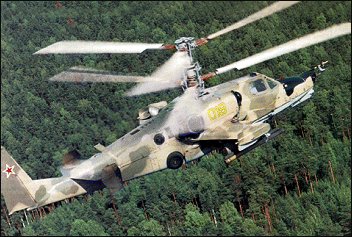
www.aviastar.org/helicopters_eng/ka-50.php
Ka-50 "Black Shark" is a single-seat attack helicopter for destroying armored vehicles, slow-speed air targets and manpower on the battlefield.Coaxial Ka-50 helicopter has two three-blade rotors of 14.5-m diameter each. The polymeric composite blade is attached to the hub by a torsion bar. The airframe features perfect aerodynamic outlines, mid-set stub wing, retractable three-leg landing gear and empennage of a fixed-wing aircraft type. The pilot cockpit is fully armored. The emergency pilot escape system, comprising an ejection seat, saves the pilot within the entire flight speed and altitude range. A set of improved survivability means allows Ka-50 to attack successfully the specified targets and to survive under intensive fire counteraction.
A coaxial rotor helicopter features: higher power-to-weight ratio due to the absence of power losses for a tail rotor; 1.5...2 times lower inertia moments of the helicopter; ability to perform a pedal (flat) turn within the full flight speed range; the best vertical rate of climb and hovering ceiling.
The load factor of 3.5G combined with the above unique qualities allows the helicopter to perform combat maneuvers within the minimum air area and the shortest time to gain an advantageous attack position.
Numerous weapons options for the helicopter are achieved by arranging a movable high-speed firing gun starboard of the helicopter, and by six available external wing stores with different combination of anti-tank missiles, rockets, "air-to-air" missiles, gun ammunition of a container type and bombs of various caliber.
Total weight of the weapons on the wing stores is 2300kg. From the point of view of the weapons power the "Black Shark" helicopter is superior to all existing combat helicopters.
The on-board avionics suite ensures helicopter piloting and control including the use of satellite navigational system, 24 hours a day, in anytime of the year. The observation, search and sighting systems comprising TV, laser and IR equipment are capable to detect targets and to fire the full arsenal of weapons in day and night conditions
-- www.airshow.ru
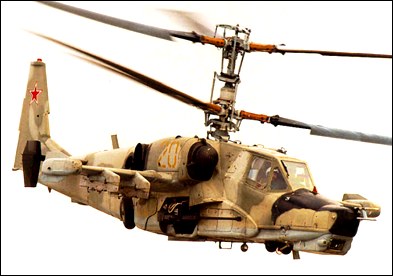
English name: Black Shark
NATO reporting name: Hokum
TYPE: Attack helicopter.
PROGRAMME: Project launched in December 1977 as V-80 (Vertolyet 80: Helicopter 80); first prototype (010) built by Kamov bureau and hovered at Lyubertsy 17 June 1982 and flew on 23 July, powered by TV3-117V engines; second prototype (011) flew 16 August 1983 with TV3-117VMA engines and mockup of Shkval tracking system, Merkury LLLTV, cannon and K-041 sighting system; both prototypes wore painted 'windows' to simulate fictitious rear cockpits. Initially reported in West in mid-1984, but first photograph did not appear (US Department of Defense's Soviet Military Power) until 1989. First prototype lost in fatal accident on 3 April 1985; replaced by third prototype (012) with Mercury LLTV system for state comparative test programme against Mil Mi-28, which completed in August 1986. Two preproduction V-80Sh-1s (014 and 015) were first to be built at Arsenyev and introduced UV 26 chaff/flare dispensers; second had K-37-800 ejection system and mockup of LLLTV in articulated turret. Ordered into production in December 1987. Further three for continued development work comprised 018 (first flown at Arsenyev 22 May 1991), 020 "Werewolf" and 021 "Black Shark". (Export marketing name was originally Werewolf, but changed to Black Shark by 1996.) State tests of Ka-50 began in mid-1991 and type was commissioned into Russian Army Aviation in August 1993 for trials at 4th Army Aviation Training Centre, Torzhok. In August 1994, the Ka-50 was included in the Russian Army inventory by Presidential decree, judged winner of the fly-off against Mi-28. The Mi-28 was nominally terminated on 5 October 1994 but the competition continued.
Further army evaluation followed when first two of four production Ka-50s were funded in 1994 and officially accepted on 28 August 1995; third and fourth received in 1996; these four numbered 20 to 23 (prompting pre-series 021 to be renumbered 024 to avoid confusion). Arsenyev production was to have increased to one per month during 1997, but this did not occur. The original Ka-50 (and rival Mi-28A) were overtaken by the issue of a revised requirement which emphasised night capability - favouring the two-seat Mi-28. The initial order for 15 Ka-50s was reportedly cancelled in September 1998, with procurement postponed until 2003. Three deployed to Mozdok during 1999 for use in Chechnya, but not used operationally. Two returned to theatre in December 2000; first firing of weapons against guerrilla forces was on 6 January 2001 (operating in conjunction with Mil Mi-24s); helicopters returned to Torzhok in March 2001. Unspecified modifications, found necessary as a consequence of operational deployment, had been incorporated by November 2002, according to a Kamov announcement.
Klimov VK-3000 turboshaft offered as alternative power plant.
CURRENT VERSIONS: Ka-50 ('Hokum'): As described.
Ka-50N (Nochnoy: Nocturnal): Also reported as Ka-50Sh. Night-capable attack version; essentially a single-seat Ka-52. Programme began 1993; originally based on TpSPO-V and Merkury LLLTV systems, which tested on Ka-50 development aircraft. Ka-50N first reported April 1997 as conversion of prototype 018 with Thomson-CSF Victor FLIR turret above the nose and Arbalet (crossbow) mast-mounted radar, plus second TV screen in cockpit; FLIR integrated with Uralskyi Optiko- Mekhanicheskyi Zavod (UOMZ) Samsh*t-50 (Laurel-50) electro-optic sighting system, incorporating French IR set. First flight variously reported as 4 March or 5 May 1997; programmed improvements included replacement of PA-4-3 paper moving map with digital equivalent; by August 1997, FLIR turret was repositioned below nose and Arbalet was removed; by mid-1998, had IT-23 CRT display replaced by TV-109, and HUD removed and replaced by Marconi helmet display. Proposed new cockpit shown in September 1998, having two Russkaya Avionika 203 x 152mm LCDs and central CRT for sensor imagery. Indigenous avionics intended for any local production orders; French systems as interim solution and standard for export. Republic of Korea Army evaluated both the Ka-50N and the baseline Ka-50. In 1999, pre-production aircraft 014 was exhibited with a UOMZ GOES sensor turret in place of Shkval.
Ka-50-2: Designation applies to three quite different aircraft. Basic Ka-50-2 is a variant of the Ka-50 single-seater, though the designation is also applied to two twin-seat aircraft; first of these was a version of the Ka-52 Alligator. All Ka-50-2s differ from the baseline Ka-52 in retaining attack and anti-tank rote using 12 laser beam-riding AT-8 Vikhr ATGMs or 16 Rafael NT-D ATGMs; avionics to be supplied by Israel Aircraft Industries, Lahav Division; 024 used as demonstrator. The basic Ka-50-2 was proposed to China, Finland, India, South Korea, Malaysia, Myanmar, Poland. South Africa, Syria and Turkey.
Second variant of Ka-50-2 is another two-seater, intended to have conventional stepped tandem cockpits; is offered to armed forces which do not accept the single-seat or side-by-side two-seat layouts. A further subvariant of the tandem-seat Ka-50-2, the Erdogan (Turkish for Born Fighter), was proposed to Turkey jointly by Kamov and Israel Aircraft Industries. This would have been fitted with longer-span wings and feature a NATO-compatible Giat 621 turret containing a single 20mm cannon which would fold down below the belly of the helicopter in flight, for a 360° arc of fire; it would fold to starboard for landing, and could be fired directly forward, even when folded. TV3- 117VMA-02 engines. Ten Turkish pilots flew Alligator "061" at Antalya, Turkey, in early 1999 as part of evaluation process; requirement was for 145. Named as second choice when Bell AH-1Z selected, but negotiations reopened in mid-2002, following impasse in negotiations with USA. Ka-52: Two-seat version.
CUSTOMERS: Four for Russian Army service trials, plus eight flying prototype and pre-series helicopters; all delivered. Further 10 ordered in 1997 budget and six in 1998, of which first three were due for delivery before end of 1998; initial helicopter eventually completed in June 1999, two more being due by mid-2000. By early 2003, it was still unclear if helicopters from the first batch of 10 had been delivered to Army Aviation. Two operational Ka-50s shown at Moscow Salon in August 2001 may have been repainted trials aircraft. One army helicopter lost in accident 17 June 1998; attributed to rotor clash.
COSTS: Unit price of Ka-50N quoted as between US$12 million and US$15 million in mid-1999.
DESIGN FEATURES: World's first single-seat close support helicopter. Coaxial, contrarotating and widely separated semi-rigid three-blade rotors, with swept blade tip, attached to hub by steel plates; small fuselage cross-section, with nose sensors; flat-screen cockpit, heavily armour protected by combined steel/aluminium armour and spaced aluminium plates, with rearview mirror above windscreen; small sweptback tailfin, with inset rudder and large tab; high-set tailplane on rear fuselage, with endplate auxiliary fins; retractable landing gear; mid-set unswept wings, carrying ECM pods at tips; four underwing weapon pylons; engines above wingroots; high agility for fast, low-flying, close-range attack role; partially dismantled can be air-ferried in Il-76 freighter. Much of fuselage skin formed by large hinged door panels, providing access to interior equipment from ground level.
FLYING CONTROLS: Kamov coaxial design; generally as Ka-32.
STRUCTURE: Fuselage built around steel torsion box beam, of 1.0m square section. Wing centre-section passes through beam. Cockpit mounted at front of beam, gearbox above and engines to sides. Carbon-based composites materials constitute 35% by weight of structure, including rotors. Approximately 350kg of armour protects pilot, engines, fuel system and ammunnion bay; canopy and windscreen panels are 55mm thick bulletproof glass.
LANDING GEAR: Hydraulically retractable tricycle type; twin-wheel steerable nose unit and single mainwheels all semi-exposed when up; all wheels retract rearward; low-pressure tyres.
POWER PLANT: Two 1,633kW Klimov TV3- 117VMA turboshafts with VR-80 main reduction gearbox and two PVR-800 intermediate gearboxes, with air intake dust filters and exhaust heat suppressors. Later use of 1,838kW TV3-117VMA-SB3 turboshafts intended. Two primary fuel tanks, filled with reticulated foam, inside fuselage box beam. Total internal capacity approximately 1,800 litres. Front tank feeds port engine; rear feeds starboard and APU. Each tank protected by layers of natural rubber. Provision for four 500 litre underwing auxiliary fuel tanks. Transmission remains operable for 30 minutes after oil system failure.
ACCOMMODATION: Double-wall steel armoured cockpit, able to protect pilot from hits by 20 and 23mm gunfire over ranges as close as 100m. Interior black-painted for use with NVGs. Specially designed Zvezda K-37-800 ejection system, ostensibly for safe ejection at any altitude (actually from 100m); following explosive separation of rotor blades and opening of cockpit roof, pilot is extracted from cockpit by large rocket; alternatively, he can jettison doors and stores before rolling out of cockpit sideways. Associated equipment includes automatic radio beacon, activated during ejection, inflatable liferaft and NAZ 7M survival kit.
SYSTEMS: All systems configured for operational deployment away from base for up to 12 days without need for maintenance ground equipment; refuelling, avionics and weapon servicing performed from ground level. AI-9V APU for engine starting, and ground supply of hydraulic and electrical power, in top of centre-fuselage. Anti-icing system for engine air intakes, rotors, AoA and yaw sensors; de-icing of windscreen and canopy by liquid spray.
PrPNK Rubikon (L-041) piloting, navigation and sighting system based on five computers: four Orbita BLVM-20-751 s for combat and navigation displays and target designation, plus one BCVM-80-30201 for WCS. Incorporates PNK-800 Radian navigation system, with C-061K pitch and heading data, IK-VSP-VI-2 speed and altitude and PA-4-3 automatic position plotting subsystems. Series 3 Tester U3 flight data recorder. Ekran BITE and warning system. KKO-VK-LP oxygen system with 2 litre supply for 90 minutes. Electrical supply from two 400kW generators at 115V 400Hz three-phase AC; 500W converter; rectifiers for 27V DC supply.
AVIONICS: Integrated by NPO Elektro Avtomatika.
Comms: Two R800L1 and one R-868 UHF transceivers. SPU-9 intercom, P-503B headset recorder, Almaz-UP-48 voice warning system and HF com/nav; IFF ('Slap Shot').
Flight: INS; autopilot; Doppler box under tailboom; ARK-22 radio compass; A-036A radio altimeter.
Instrumentation: Conventional instruments; ILS-31 HUD; moving map display (Kronshtadt Abris on some aircraft); small IT-23MV CRT beneath HUD, with rubber hood, to display only FLIR and monochrome LLLTV imagery. Pilot has Obzor-800 helmet sight effective within ±60° azimuth and from -20 to +45° elevation; when pilot has target centred on HUD, he pushes button to lock sighting and four-channel digital autopilot into one unit. Displays compatible with OVN-1 Skosok NVGs.
Mission: To reduce pilot workload and introduce a degree of low observability, target location and designation are assigned to other aircraft; equipment behind windows in nose includes I-25IV Shkval-V daylight electro-optical search and auto-tracking system, laser marked target seeker and range-finder; FOV ±35° in azimuth +15 to -80° in elevation. FLIR turret to be added in nose for use with NVGs.
Self-defence: L150 Pastel RWR in tailcone, at rear of each wingtip EW pod and under nose; total of 512 chaff/ flare cartridges (in four UV-26 dispensers) in each wingtip pod. L-140 Otklik laser detection system; L-136 Mak IR warning.
ARMAMENT: Four BD3-UV pylons on wings. Up to 80 S-8 80mm air-to-surface rockets in four underwing B8V20A packs or 20 S-13 122mm rockets in four B-13L pods; or up to 12 9A4172 Vikhr-M (AT-12) tube-launched laser-guided ASMs with range of 8 to 10km capable of penetrating 900mm of reactive armour; or mix of both; Vikhr launched from trainable UPP-800 mounts, which can be depressed to -12°; single-barrel 30mm 2A42 gun on starboard side of fuselage, with up to 470 armour-piercing or high-explosive fragmentation rounds, can be depressed from +3° 30' to -37° in elevation and traversed from -2° 30' to +9° in azimuth hydraulically and is kept on target in azimuth by tracker which turns helicopter on its axis; two ammunition boxes in centre-fuselage. Front box contains 240 AP rounds, rear box 230 HE rounds. Selectable rapid (550 to 600 rds/min) or slow (350 rds/min) fire, with bursts of 10 or 20 rounds. Provision for alternative weapons, including UPK-23-250 23mm gun pods, Igla or R-73 (AA-11 'Archer') AAMs. Kh-25MP (AS-12 'Kegler') ARMs, FAB-500 bombs or dispenser weapons.
--Jane's All the World's Aircraft, 2004-2005
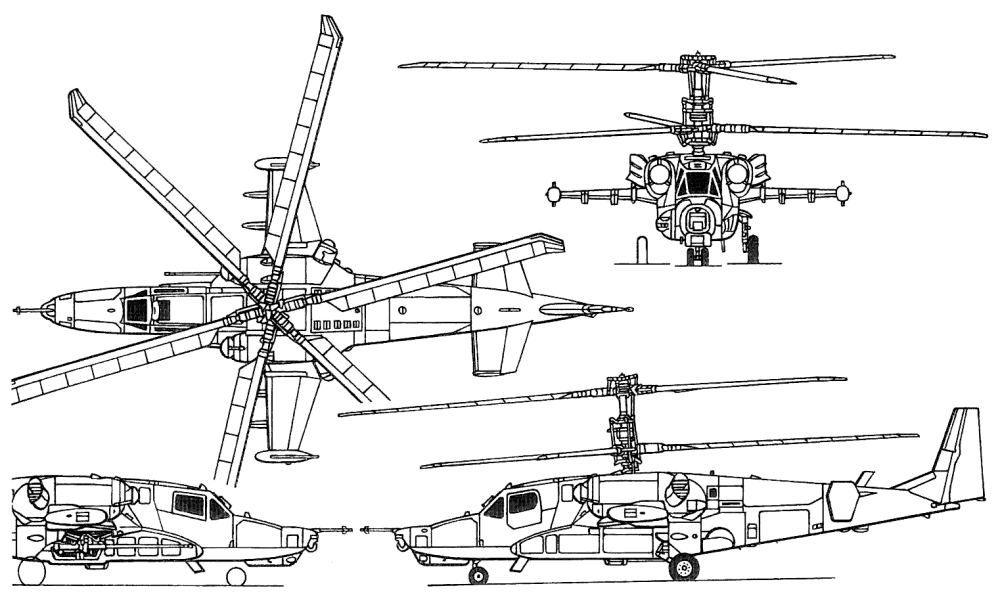
Technical data for Ka-50
Crew: 1, engine: 2 x TV3-117 turboshaft, rated at 1618kW, rotor diameter: 14.5m, length with rotors turning: 16.0m, take-off weight: 10800kg, empty weight: 7700kg, max speed: 310km/h, rate of climb: 10.0m/s, hovering ceiling, OGE: 4000m, range with max payload: 450km, range with max fuel: 1200km
--------------------------------------------------------------------------------
Kamov Ka-50Sh "Night Shark"
1997
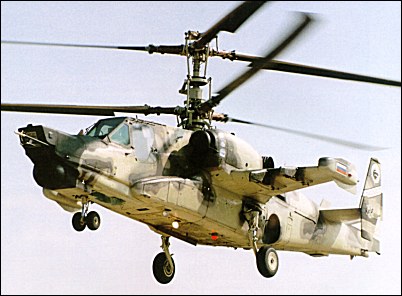
www.aviastar.org/helicopters_eng/ka-50sh.php
The helicopter Ka-50SH, unlike the daily basic helicopter Ka-50, serves out its tasks around the clock.
Õðîíîëîãèÿ ñîçäàíèÿ: Chronology of establishment:
Ïîñòàíîâëåíèå ÖÊ ÊÏÑÑ è ÑÌ ÑÑÑÐ ¹1420-355 î ñîçäàíèè êðóãëîñóòî÷íîãî Êà-50Ø — 1987 ãîä; Enactment of the Central Committee of the CPSU and the Soviet Union SM ¹ 1420-355 to establish round-the-clock Ka-50SH - 1987 year;
çàâåðøåíèå ýñêèçíîãî ïðîåêòà — 1993 ãîä; completion of the project design - 1993 year;
ïîñòðîéêà îïûòíîãî îáðàçöà — 1997 ãîä. construction of a prototype - 1997 year.
Êà-50Ø îòëè÷àåòñÿ îò ñâîåãî ïðåäøåñòâåííèêà âíåøíèì âèäîì íîñîâîé ÷àñòè, êîòîðàÿ ïåðåêîìïîíîâàíà ïîä ñîâìåñòíîå ðàçìåùåíèå äíåâíîãî ëàçåðíî-òåëåâèçèîííîãî è íî÷íîãî òåïëîâèçèîííîãî êàíàëîâ ïðèöåëüíî-ïèëîòàæíî -íàâèãàöèîííîãî êîìïëåêñà "Ðóáèêîí-Í". Ka-50SH different from his predecessor's appearance bow, which perekomponovana under the co-location of laser-television day and night sighting channels thermal-flight - navigational complex "Rubicon-N". Äíåâíîé êàíàë èç-ïîä íîñîâîé ÷àñòè ôþçåëÿæà ïåðåíåñåí íà íåå âî âíîâü ñîçäàííûé îáòåêàòåëü, êîòîðûé íåñêîëüêî âûòÿíóò âïåðåä. Daily feed from under the bow of the fuselage moved into its newly created fairing, which is somewhat stretched forward. Ïîä íîñîâîé ÷àñòüþ ôþçåëÿæà, íà ìåñòå ïðåæíåãî ðàñïîëîæåíèÿ äíåâíîãî êàíàëà, íàõîäèòñÿ ïîäâèæíûé øàð äèàìåòðîì 640ìì, â êîòîðîì íà ãèðîñòàáèëèçèðîâàííîé ïëàòôîðìå ñìîíòèðîâàíà îáçîðíî-ïðèöåëüíàÿ òåïëîâèçèîííàÿ àïïàðàòóðà. Under the bow of the fuselage at the site of the former location of daylight channel, mobile ball diameter is 640 mm, which is a platform mounted an overview girostabilizirovannoy-thermal sighting equipment.
Êàáèíà ïèëîòà îáîðóäîâàíà ñèíå- çåëåíûì ïîäñâåòîì ïðèáîðîâ, îáåñïå÷èâàþùèì ñîâìåñòèìîñòü ñ íî÷íûìè ñèñòåìàìè. The cab driver is equipped with blue-green podsvetom devices, providing compatibility with night systems. Íà çàùèòíîì øëåìå ëåò÷èêà óñòàíîâëåíû î÷êè íî÷íîãî âèäåíèÿ äëÿ îñóùåñòâëåíèÿ ïèëîòèðîâàíèÿ ìàøèíû â òåìíîå âðåìÿ ñóòîê. At protective helmet fitted pilot night vision goggles for the implementation of piloting vehicles at night. Ïèëîòàæíî-íàâèãàöèîííûé êîìïëåêñ áàçîâîãî âåðòîëåòà äîïîëíåí àïïàðàòóðîé ñïóòíèêîâîé íàâèãàöèè. Flight and Navigation helicopters supplemented by a set of basic satellite navigation equipment. Àâòîìàòè÷åñêèé êàðòîãðàôè÷åñêèé ïëàíøåò ÏÀ-4-3 çàìåíåí íà öâåòíîé èíäèêàòîð ñ öèôðîâîé êàðòîé ìåñòíîñòè. Automatic mapping tablet PA-4-3 replaced by the color indicator with digital terrain map.
Îáçîðíî-ïðèöåëüíàÿ òåïëîâèçèîííàÿ ñèñòåìà "Ñàìøèò-50" ðàçðàáîòêè Óðàëüñêîãî îïòèêî -ìåõàíè÷åñêîãî çàâîäà (ÓÎÌÇ) ïðåäñòàâëÿåò ñîáîé êîìïàêòíûé ìîäóëü â âèäå ïîäâèæíîãî øàðà (ñ òðåìÿ îïòè÷åñêèìè îêíàìè). Review thermal-sighting system "Samsh*t-50" development of the Urals Optical - Mechanical Plant (UOMZ) is a compact module in the form of rolling the ball (with three optical windows).  äàëüíåéøåì ïðåäïîëàãàåòñÿ óñòàíîâêà îòå÷åñòâåííîãî òåïëîâèçîðà âìåñòî èíîñòðàííîãî îáðàçöà äëÿ îñíàùåíèÿ âèíòîêðûëûõ øòóðìîâèêîâ àðìåéñêîé àâèàöèè ñòðàíû. In the future, it is the installation of domestic teplovizora instead of a foreign model for equipping the army aviation vintokrylyh gunships country. Íî÷íîé êàíàë êîìïëåêñà "Ðóáèêîí-Í" ïîëíîñòüþ àäàïòèðîâàí ê ÎÏÑ äëÿ àâòîìàòè÷åñêîãî ïðèìåíåíèÿ ñðåäñòâ ïîðàæåíèÿ ïî íàçåìíûì è âîçäóøíûì öåëÿì, àíàëîãè÷íî äíåâíîìó êàíàëó. Night channel complex "Rubicon-N" fully adapted to the OPS for the automatic use of means of destruction on land and air targets, in the same day the channel. Íî÷íîå îáîðóäîâàíèå ïîçâîëÿåò îáíàðóæèâàòü ìàëîðàçìåðíûå öåëè òèïà òàíê íà óäàëåíèè 7êì è ïðîèçâîäèòü ïðèöåëèâàíèå íà äàëüíîñòÿõ 4.5-5êì. Night equipment allows detecting small goal type tank at a distance of 7 km and aiming to produce 4.5-5 km range.
Ðàçìåùåíèå àíòåííû ÐËÑ â íåáîëüøîì îáòåêàòåëå íàä âòóëêîé âåðõíåãî íåñóùåãî âèíòà îáåñïå÷èâàåò ðåøåíèå çàäà÷ íàâèãàöèè è ïðîòèâîðàêåòíîé îáîðîíû íà íîâîì óðîâíå. Placing the radar antenna in a small fairing on the upper bearing screw socket provides the tasks of navigation and missile defense at a new level.
Ïëàíèðóåòñÿ è "îáðàòíàÿ" ìîäåðíèçàöèÿ âåðòîëåòà Êà-50 . Planned and "backward" modernize helicopters Ka-50. ×àñòü äîðàáîòîê, âûïîëíåííûõ íà Êà- 50Ø, áóäåò ðåàëèçîâàíà òàêæå è íà äíåâíîé áàçîâîé ìîäåëè, â ÷àñòíîñòè, íà íåé áóäóò óñòàíîâëåíû ñèñòåìà ñïóòíèêîâîé íàâèãàöèè, öâåòíîé ýêðàí ñ öèôðîâîé êàðòîé ìåñòíîñòè, íàäâòóëî÷íàÿ ÐËÑ è äðóãîå îáîðóäîâàíèå. Some improvements made at Ka-50 W, will be implemented also in the daily basic model, in particular, it will be installed satellite navigation system, a color screen with a digital map terrain, nadvtulochnaya radar and other equipment.
--------------------------------------------------------------------------------
Kamov Ka-52 "Alligator" (NATO "Hokum-B")
1997
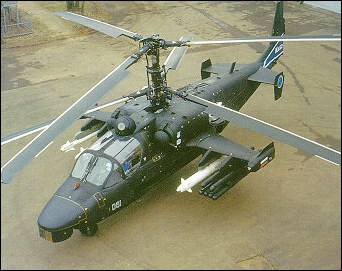
www.aviastar.org/helicopters_eng/ka-52.php
Multi-role all-weather combat Ka-52 "Alligator" helicopter is a twin-seat derivative of the attack Ka-50. It is intended for a wide range of combat tasks in daytime and night conditions, in any time of the year with the use of all destruction means of the Ka-50. This is a commander helicopter of the army aviation aimed at increasing the efficiency of group combat helicopter operations.
Coaxial-type Ka-52 helicopter differs from its predecessor by a wider nose part and twin-seat crew cockpit where the pilot ejection seats are arranged side-by-side. Both pilots have full controls of the helicopter without any limitations. The pilot cockpit is armored. The helicopter can be used as a trainer. High flying qualities of the coaxial helicopter combined with unique manoeuvrability allow the helicopter to perform combat maneuvers within the minimum air area and the shortest time to gain an advantageous attack position.
Numerous weapons options for the helicopter are achieved by arranging a movable high-speed firing gun starboard of the helicopter, and by six available external wing stores with different combination of anti-tank missiles, rockets, "air-to-air" missiles, gun ammunition of a container type and bombs of various caliber. From the point of view of the weapons power the "Alligator" is comparable with the "Black Shark" helicopter and is superior to all existing combat helicopters.
The on-board multifunctional avionics suite ensures round-the-clock helicopter piloting, navigational and combat tasks in anytime of the year. The avionics suite is comprised of a multiplexed, multi-level digital computer-based system having large storage capacity and high speed. Observation, search and targeting systems comprising head-mounted display are used for round-the-clock and all-weather detection of specified targets and their attack using optical, TV, laser, IR and radar equipment.
-- www.airshow.ru
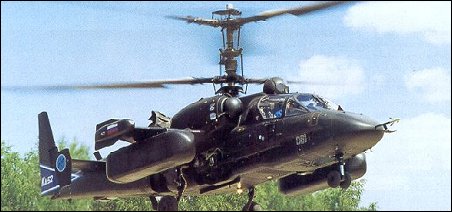
NATO reporting name: Hokum-B
TYPE: Two-seat all-weather day/night combat and training helicopter.
PROGRAMME: Revealed at 1995 Paris Air Show; rolled out December 1996; first flight 25 June 1997; first official flight 1 July 1997.
DESIGN FEATURES: 85% similar to single-seat Ka-50, but front fuselage redesigned to accommodate two crew side by side; upward-hinged and bulged gull-wing type transparent canopy door over each seat. Bottom of nose recessed on starboard side to improve field of fire of 2A42 gun. Some cockpit armour and number of rounds for the cannon omitted to compensate for increased weight.
POWER PLANT: Two uprated 1,863kW Klimov TV3-117VMA-SB3 turboshafts. Two 1,633kW TV3-117VMA turboshafts in prototype.
ACCOMMODATION: Pilot and pupil or navigator/weapons operator have Zvezda K-37-800 ejection system, for simultaneous emergency escape, similar to that of Ka-50. Full dual controls standard including two colour and two monochrome SMD 66 multifunction displays.
AVIONICS: Integrated by Sextant Avionique, supplier of head-down displays, the Navigation and Attack System for Helicopters (NASH), Topowl helmet-mounted sight display, Nadir 10 navigation system.
Radar: Phazotron FH-01 Arbalet MMW radar installed in mast-mounted dome.
Flight: Nadir 10 nav system with Stratus laser gyro AHRS and Doppler radar.
Instrumentation: Arsenal Shchel-V helmet-mounted sight for weapons operator.
Mission: Samsh*t-E weapons control system above and behind the second cockpit, with TV, FLIR and laser range-finder and target designator. Thomson-CSF FLIR (or optional Russian Khod FLIR) integrated with Shkval electro-optical (TV) sighting system in ball above fuselage aft of canopy. Smaller ball for optical sight under fuselage. Windows for laser range-finder and IR camera in nose turret.
Self-defence: Active IR and electronic jamming units; UV-26 flare/chaff dispensers in wingtip fairings. Warning equipment includes Pastel (L150) RWR, Mak (L136) IR and Otklik (L140) laser system.
ARMAMENT: As Ka-50, except only 240 rounds for 2A42 gun, plus additional weapons. Standard Ka-52 armament comprises two UPP-800 clusters on inner underwing hardpoints, each equipped with six laser-guided Vikhr anti-tank missiles with a range of 8 to 10km, and two B8V-20 rocket launchers on the outer hardpoints, each with 20 S-8 80mm air-to-surface rockets; 30mm fixed 2A42 gun on starboard side of fuselage. New Vikhr-M anti-tank missile with a range of 12 to 15km will be fitted to production aircraft. Igla-V AAMs are carried for air-to-air defence.
--Jane's Helicopter Markets and Systems
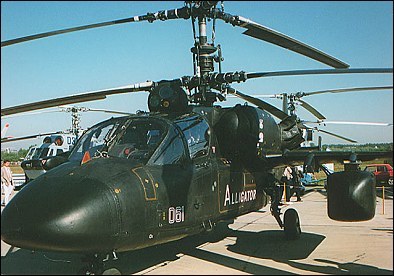
Technical data for Ka-52
Crew: 2, rotor diameter: 14.50m, fuselage length: 13.53m, height: 4.95m, take-off weight: 10800kg, max speed: 300km/h, hovering ceiling, OGE: 3600m, normal range: 520km, range with max fuel: 1200km, armament: 1 x 30mm cannon, 12 "Vihr" anti-tank missiles
--------------------------------------------------------------------------------
Kamov Ka-50-2 "Erdogan"
1999
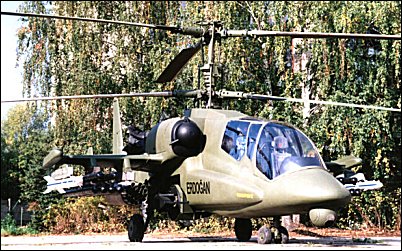
www.aviastar.org/helicopters_eng/ka-50-2.php
Second variant of Ka-50-2 is another two-seater, intended to have conventional stepped tandem cockpits; is offered to armed forces which do not accept the single-seat or side-by-side two-seat layouts. A further subvariant of the tandem-seat Ka-50-2, the Erdogan (Turkish for Born Fighter), was proposed to Turkey jointly by Kamov and Israel Aircraft Industries. This would have been fitted with longer-span wings and feature a NATO-compatible Giat 621 turret containing a single 20mm cannon which would fold down below the belly of the helicopter in flight, for a 360° arc of fire; it would fold to starboard for landing, and could be fired directly forward, even when folded. TV3- 117VMA-02 engines. Ten Turkish pilots flew Alligator "061" at Antalya, Turkey, in early 1999 as part of evaluation process; requirement was for 145. Named as second choice when Bell AH-1Z selected, but negotiations reopened in mid-2002, following impasse in negotiations with USA.
--Jane's All the World's Aircraft, 2004-2005
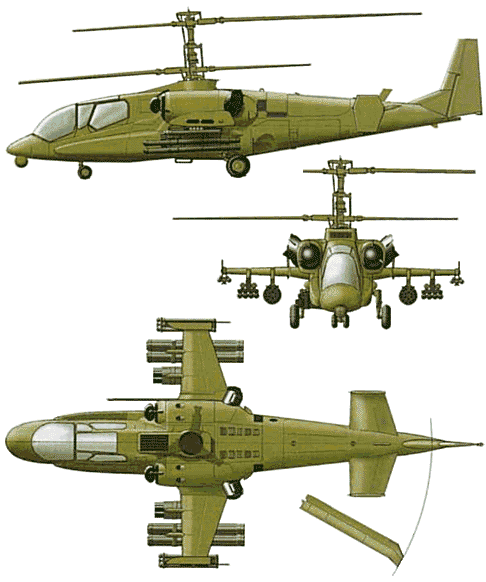
1982
--------------------------------------------------------------------------------
Originally known as Ka-41 before its real name was released. Prototype designated V-80, referred to as "Warewolf", originally known as Ka-34 "Hokum".

www.aviastar.org/helicopters_eng/ka-50.php
Ka-50 "Black Shark" is a single-seat attack helicopter for destroying armored vehicles, slow-speed air targets and manpower on the battlefield.Coaxial Ka-50 helicopter has two three-blade rotors of 14.5-m diameter each. The polymeric composite blade is attached to the hub by a torsion bar. The airframe features perfect aerodynamic outlines, mid-set stub wing, retractable three-leg landing gear and empennage of a fixed-wing aircraft type. The pilot cockpit is fully armored. The emergency pilot escape system, comprising an ejection seat, saves the pilot within the entire flight speed and altitude range. A set of improved survivability means allows Ka-50 to attack successfully the specified targets and to survive under intensive fire counteraction.
A coaxial rotor helicopter features: higher power-to-weight ratio due to the absence of power losses for a tail rotor; 1.5...2 times lower inertia moments of the helicopter; ability to perform a pedal (flat) turn within the full flight speed range; the best vertical rate of climb and hovering ceiling.
The load factor of 3.5G combined with the above unique qualities allows the helicopter to perform combat maneuvers within the minimum air area and the shortest time to gain an advantageous attack position.
Numerous weapons options for the helicopter are achieved by arranging a movable high-speed firing gun starboard of the helicopter, and by six available external wing stores with different combination of anti-tank missiles, rockets, "air-to-air" missiles, gun ammunition of a container type and bombs of various caliber.
Total weight of the weapons on the wing stores is 2300kg. From the point of view of the weapons power the "Black Shark" helicopter is superior to all existing combat helicopters.
The on-board avionics suite ensures helicopter piloting and control including the use of satellite navigational system, 24 hours a day, in anytime of the year. The observation, search and sighting systems comprising TV, laser and IR equipment are capable to detect targets and to fire the full arsenal of weapons in day and night conditions
-- www.airshow.ru

English name: Black Shark
NATO reporting name: Hokum
TYPE: Attack helicopter.
PROGRAMME: Project launched in December 1977 as V-80 (Vertolyet 80: Helicopter 80); first prototype (010) built by Kamov bureau and hovered at Lyubertsy 17 June 1982 and flew on 23 July, powered by TV3-117V engines; second prototype (011) flew 16 August 1983 with TV3-117VMA engines and mockup of Shkval tracking system, Merkury LLLTV, cannon and K-041 sighting system; both prototypes wore painted 'windows' to simulate fictitious rear cockpits. Initially reported in West in mid-1984, but first photograph did not appear (US Department of Defense's Soviet Military Power) until 1989. First prototype lost in fatal accident on 3 April 1985; replaced by third prototype (012) with Mercury LLTV system for state comparative test programme against Mil Mi-28, which completed in August 1986. Two preproduction V-80Sh-1s (014 and 015) were first to be built at Arsenyev and introduced UV 26 chaff/flare dispensers; second had K-37-800 ejection system and mockup of LLLTV in articulated turret. Ordered into production in December 1987. Further three for continued development work comprised 018 (first flown at Arsenyev 22 May 1991), 020 "Werewolf" and 021 "Black Shark". (Export marketing name was originally Werewolf, but changed to Black Shark by 1996.) State tests of Ka-50 began in mid-1991 and type was commissioned into Russian Army Aviation in August 1993 for trials at 4th Army Aviation Training Centre, Torzhok. In August 1994, the Ka-50 was included in the Russian Army inventory by Presidential decree, judged winner of the fly-off against Mi-28. The Mi-28 was nominally terminated on 5 October 1994 but the competition continued.
Further army evaluation followed when first two of four production Ka-50s were funded in 1994 and officially accepted on 28 August 1995; third and fourth received in 1996; these four numbered 20 to 23 (prompting pre-series 021 to be renumbered 024 to avoid confusion). Arsenyev production was to have increased to one per month during 1997, but this did not occur. The original Ka-50 (and rival Mi-28A) were overtaken by the issue of a revised requirement which emphasised night capability - favouring the two-seat Mi-28. The initial order for 15 Ka-50s was reportedly cancelled in September 1998, with procurement postponed until 2003. Three deployed to Mozdok during 1999 for use in Chechnya, but not used operationally. Two returned to theatre in December 2000; first firing of weapons against guerrilla forces was on 6 January 2001 (operating in conjunction with Mil Mi-24s); helicopters returned to Torzhok in March 2001. Unspecified modifications, found necessary as a consequence of operational deployment, had been incorporated by November 2002, according to a Kamov announcement.
Klimov VK-3000 turboshaft offered as alternative power plant.
CURRENT VERSIONS: Ka-50 ('Hokum'): As described.
Ka-50N (Nochnoy: Nocturnal): Also reported as Ka-50Sh. Night-capable attack version; essentially a single-seat Ka-52. Programme began 1993; originally based on TpSPO-V and Merkury LLLTV systems, which tested on Ka-50 development aircraft. Ka-50N first reported April 1997 as conversion of prototype 018 with Thomson-CSF Victor FLIR turret above the nose and Arbalet (crossbow) mast-mounted radar, plus second TV screen in cockpit; FLIR integrated with Uralskyi Optiko- Mekhanicheskyi Zavod (UOMZ) Samsh*t-50 (Laurel-50) electro-optic sighting system, incorporating French IR set. First flight variously reported as 4 March or 5 May 1997; programmed improvements included replacement of PA-4-3 paper moving map with digital equivalent; by August 1997, FLIR turret was repositioned below nose and Arbalet was removed; by mid-1998, had IT-23 CRT display replaced by TV-109, and HUD removed and replaced by Marconi helmet display. Proposed new cockpit shown in September 1998, having two Russkaya Avionika 203 x 152mm LCDs and central CRT for sensor imagery. Indigenous avionics intended for any local production orders; French systems as interim solution and standard for export. Republic of Korea Army evaluated both the Ka-50N and the baseline Ka-50. In 1999, pre-production aircraft 014 was exhibited with a UOMZ GOES sensor turret in place of Shkval.
Ka-50-2: Designation applies to three quite different aircraft. Basic Ka-50-2 is a variant of the Ka-50 single-seater, though the designation is also applied to two twin-seat aircraft; first of these was a version of the Ka-52 Alligator. All Ka-50-2s differ from the baseline Ka-52 in retaining attack and anti-tank rote using 12 laser beam-riding AT-8 Vikhr ATGMs or 16 Rafael NT-D ATGMs; avionics to be supplied by Israel Aircraft Industries, Lahav Division; 024 used as demonstrator. The basic Ka-50-2 was proposed to China, Finland, India, South Korea, Malaysia, Myanmar, Poland. South Africa, Syria and Turkey.
Second variant of Ka-50-2 is another two-seater, intended to have conventional stepped tandem cockpits; is offered to armed forces which do not accept the single-seat or side-by-side two-seat layouts. A further subvariant of the tandem-seat Ka-50-2, the Erdogan (Turkish for Born Fighter), was proposed to Turkey jointly by Kamov and Israel Aircraft Industries. This would have been fitted with longer-span wings and feature a NATO-compatible Giat 621 turret containing a single 20mm cannon which would fold down below the belly of the helicopter in flight, for a 360° arc of fire; it would fold to starboard for landing, and could be fired directly forward, even when folded. TV3- 117VMA-02 engines. Ten Turkish pilots flew Alligator "061" at Antalya, Turkey, in early 1999 as part of evaluation process; requirement was for 145. Named as second choice when Bell AH-1Z selected, but negotiations reopened in mid-2002, following impasse in negotiations with USA. Ka-52: Two-seat version.
CUSTOMERS: Four for Russian Army service trials, plus eight flying prototype and pre-series helicopters; all delivered. Further 10 ordered in 1997 budget and six in 1998, of which first three were due for delivery before end of 1998; initial helicopter eventually completed in June 1999, two more being due by mid-2000. By early 2003, it was still unclear if helicopters from the first batch of 10 had been delivered to Army Aviation. Two operational Ka-50s shown at Moscow Salon in August 2001 may have been repainted trials aircraft. One army helicopter lost in accident 17 June 1998; attributed to rotor clash.
COSTS: Unit price of Ka-50N quoted as between US$12 million and US$15 million in mid-1999.
DESIGN FEATURES: World's first single-seat close support helicopter. Coaxial, contrarotating and widely separated semi-rigid three-blade rotors, with swept blade tip, attached to hub by steel plates; small fuselage cross-section, with nose sensors; flat-screen cockpit, heavily armour protected by combined steel/aluminium armour and spaced aluminium plates, with rearview mirror above windscreen; small sweptback tailfin, with inset rudder and large tab; high-set tailplane on rear fuselage, with endplate auxiliary fins; retractable landing gear; mid-set unswept wings, carrying ECM pods at tips; four underwing weapon pylons; engines above wingroots; high agility for fast, low-flying, close-range attack role; partially dismantled can be air-ferried in Il-76 freighter. Much of fuselage skin formed by large hinged door panels, providing access to interior equipment from ground level.
FLYING CONTROLS: Kamov coaxial design; generally as Ka-32.
STRUCTURE: Fuselage built around steel torsion box beam, of 1.0m square section. Wing centre-section passes through beam. Cockpit mounted at front of beam, gearbox above and engines to sides. Carbon-based composites materials constitute 35% by weight of structure, including rotors. Approximately 350kg of armour protects pilot, engines, fuel system and ammunnion bay; canopy and windscreen panels are 55mm thick bulletproof glass.
LANDING GEAR: Hydraulically retractable tricycle type; twin-wheel steerable nose unit and single mainwheels all semi-exposed when up; all wheels retract rearward; low-pressure tyres.
POWER PLANT: Two 1,633kW Klimov TV3- 117VMA turboshafts with VR-80 main reduction gearbox and two PVR-800 intermediate gearboxes, with air intake dust filters and exhaust heat suppressors. Later use of 1,838kW TV3-117VMA-SB3 turboshafts intended. Two primary fuel tanks, filled with reticulated foam, inside fuselage box beam. Total internal capacity approximately 1,800 litres. Front tank feeds port engine; rear feeds starboard and APU. Each tank protected by layers of natural rubber. Provision for four 500 litre underwing auxiliary fuel tanks. Transmission remains operable for 30 minutes after oil system failure.
ACCOMMODATION: Double-wall steel armoured cockpit, able to protect pilot from hits by 20 and 23mm gunfire over ranges as close as 100m. Interior black-painted for use with NVGs. Specially designed Zvezda K-37-800 ejection system, ostensibly for safe ejection at any altitude (actually from 100m); following explosive separation of rotor blades and opening of cockpit roof, pilot is extracted from cockpit by large rocket; alternatively, he can jettison doors and stores before rolling out of cockpit sideways. Associated equipment includes automatic radio beacon, activated during ejection, inflatable liferaft and NAZ 7M survival kit.
SYSTEMS: All systems configured for operational deployment away from base for up to 12 days without need for maintenance ground equipment; refuelling, avionics and weapon servicing performed from ground level. AI-9V APU for engine starting, and ground supply of hydraulic and electrical power, in top of centre-fuselage. Anti-icing system for engine air intakes, rotors, AoA and yaw sensors; de-icing of windscreen and canopy by liquid spray.
PrPNK Rubikon (L-041) piloting, navigation and sighting system based on five computers: four Orbita BLVM-20-751 s for combat and navigation displays and target designation, plus one BCVM-80-30201 for WCS. Incorporates PNK-800 Radian navigation system, with C-061K pitch and heading data, IK-VSP-VI-2 speed and altitude and PA-4-3 automatic position plotting subsystems. Series 3 Tester U3 flight data recorder. Ekran BITE and warning system. KKO-VK-LP oxygen system with 2 litre supply for 90 minutes. Electrical supply from two 400kW generators at 115V 400Hz three-phase AC; 500W converter; rectifiers for 27V DC supply.
AVIONICS: Integrated by NPO Elektro Avtomatika.
Comms: Two R800L1 and one R-868 UHF transceivers. SPU-9 intercom, P-503B headset recorder, Almaz-UP-48 voice warning system and HF com/nav; IFF ('Slap Shot').
Flight: INS; autopilot; Doppler box under tailboom; ARK-22 radio compass; A-036A radio altimeter.
Instrumentation: Conventional instruments; ILS-31 HUD; moving map display (Kronshtadt Abris on some aircraft); small IT-23MV CRT beneath HUD, with rubber hood, to display only FLIR and monochrome LLLTV imagery. Pilot has Obzor-800 helmet sight effective within ±60° azimuth and from -20 to +45° elevation; when pilot has target centred on HUD, he pushes button to lock sighting and four-channel digital autopilot into one unit. Displays compatible with OVN-1 Skosok NVGs.
Mission: To reduce pilot workload and introduce a degree of low observability, target location and designation are assigned to other aircraft; equipment behind windows in nose includes I-25IV Shkval-V daylight electro-optical search and auto-tracking system, laser marked target seeker and range-finder; FOV ±35° in azimuth +15 to -80° in elevation. FLIR turret to be added in nose for use with NVGs.
Self-defence: L150 Pastel RWR in tailcone, at rear of each wingtip EW pod and under nose; total of 512 chaff/ flare cartridges (in four UV-26 dispensers) in each wingtip pod. L-140 Otklik laser detection system; L-136 Mak IR warning.
ARMAMENT: Four BD3-UV pylons on wings. Up to 80 S-8 80mm air-to-surface rockets in four underwing B8V20A packs or 20 S-13 122mm rockets in four B-13L pods; or up to 12 9A4172 Vikhr-M (AT-12) tube-launched laser-guided ASMs with range of 8 to 10km capable of penetrating 900mm of reactive armour; or mix of both; Vikhr launched from trainable UPP-800 mounts, which can be depressed to -12°; single-barrel 30mm 2A42 gun on starboard side of fuselage, with up to 470 armour-piercing or high-explosive fragmentation rounds, can be depressed from +3° 30' to -37° in elevation and traversed from -2° 30' to +9° in azimuth hydraulically and is kept on target in azimuth by tracker which turns helicopter on its axis; two ammunition boxes in centre-fuselage. Front box contains 240 AP rounds, rear box 230 HE rounds. Selectable rapid (550 to 600 rds/min) or slow (350 rds/min) fire, with bursts of 10 or 20 rounds. Provision for alternative weapons, including UPK-23-250 23mm gun pods, Igla or R-73 (AA-11 'Archer') AAMs. Kh-25MP (AS-12 'Kegler') ARMs, FAB-500 bombs or dispenser weapons.
--Jane's All the World's Aircraft, 2004-2005

Technical data for Ka-50
Crew: 1, engine: 2 x TV3-117 turboshaft, rated at 1618kW, rotor diameter: 14.5m, length with rotors turning: 16.0m, take-off weight: 10800kg, empty weight: 7700kg, max speed: 310km/h, rate of climb: 10.0m/s, hovering ceiling, OGE: 4000m, range with max payload: 450km, range with max fuel: 1200km
--------------------------------------------------------------------------------
Kamov Ka-50Sh "Night Shark"
1997

www.aviastar.org/helicopters_eng/ka-50sh.php
The helicopter Ka-50SH, unlike the daily basic helicopter Ka-50, serves out its tasks around the clock.
Õðîíîëîãèÿ ñîçäàíèÿ: Chronology of establishment:
Ïîñòàíîâëåíèå ÖÊ ÊÏÑÑ è ÑÌ ÑÑÑÐ ¹1420-355 î ñîçäàíèè êðóãëîñóòî÷íîãî Êà-50Ø — 1987 ãîä; Enactment of the Central Committee of the CPSU and the Soviet Union SM ¹ 1420-355 to establish round-the-clock Ka-50SH - 1987 year;
çàâåðøåíèå ýñêèçíîãî ïðîåêòà — 1993 ãîä; completion of the project design - 1993 year;
ïîñòðîéêà îïûòíîãî îáðàçöà — 1997 ãîä. construction of a prototype - 1997 year.
Êà-50Ø îòëè÷àåòñÿ îò ñâîåãî ïðåäøåñòâåííèêà âíåøíèì âèäîì íîñîâîé ÷àñòè, êîòîðàÿ ïåðåêîìïîíîâàíà ïîä ñîâìåñòíîå ðàçìåùåíèå äíåâíîãî ëàçåðíî-òåëåâèçèîííîãî è íî÷íîãî òåïëîâèçèîííîãî êàíàëîâ ïðèöåëüíî-ïèëîòàæíî -íàâèãàöèîííîãî êîìïëåêñà "Ðóáèêîí-Í". Ka-50SH different from his predecessor's appearance bow, which perekomponovana under the co-location of laser-television day and night sighting channels thermal-flight - navigational complex "Rubicon-N". Äíåâíîé êàíàë èç-ïîä íîñîâîé ÷àñòè ôþçåëÿæà ïåðåíåñåí íà íåå âî âíîâü ñîçäàííûé îáòåêàòåëü, êîòîðûé íåñêîëüêî âûòÿíóò âïåðåä. Daily feed from under the bow of the fuselage moved into its newly created fairing, which is somewhat stretched forward. Ïîä íîñîâîé ÷àñòüþ ôþçåëÿæà, íà ìåñòå ïðåæíåãî ðàñïîëîæåíèÿ äíåâíîãî êàíàëà, íàõîäèòñÿ ïîäâèæíûé øàð äèàìåòðîì 640ìì, â êîòîðîì íà ãèðîñòàáèëèçèðîâàííîé ïëàòôîðìå ñìîíòèðîâàíà îáçîðíî-ïðèöåëüíàÿ òåïëîâèçèîííàÿ àïïàðàòóðà. Under the bow of the fuselage at the site of the former location of daylight channel, mobile ball diameter is 640 mm, which is a platform mounted an overview girostabilizirovannoy-thermal sighting equipment.
Êàáèíà ïèëîòà îáîðóäîâàíà ñèíå- çåëåíûì ïîäñâåòîì ïðèáîðîâ, îáåñïå÷èâàþùèì ñîâìåñòèìîñòü ñ íî÷íûìè ñèñòåìàìè. The cab driver is equipped with blue-green podsvetom devices, providing compatibility with night systems. Íà çàùèòíîì øëåìå ëåò÷èêà óñòàíîâëåíû î÷êè íî÷íîãî âèäåíèÿ äëÿ îñóùåñòâëåíèÿ ïèëîòèðîâàíèÿ ìàøèíû â òåìíîå âðåìÿ ñóòîê. At protective helmet fitted pilot night vision goggles for the implementation of piloting vehicles at night. Ïèëîòàæíî-íàâèãàöèîííûé êîìïëåêñ áàçîâîãî âåðòîëåòà äîïîëíåí àïïàðàòóðîé ñïóòíèêîâîé íàâèãàöèè. Flight and Navigation helicopters supplemented by a set of basic satellite navigation equipment. Àâòîìàòè÷åñêèé êàðòîãðàôè÷åñêèé ïëàíøåò ÏÀ-4-3 çàìåíåí íà öâåòíîé èíäèêàòîð ñ öèôðîâîé êàðòîé ìåñòíîñòè. Automatic mapping tablet PA-4-3 replaced by the color indicator with digital terrain map.
Îáçîðíî-ïðèöåëüíàÿ òåïëîâèçèîííàÿ ñèñòåìà "Ñàìøèò-50" ðàçðàáîòêè Óðàëüñêîãî îïòèêî -ìåõàíè÷åñêîãî çàâîäà (ÓÎÌÇ) ïðåäñòàâëÿåò ñîáîé êîìïàêòíûé ìîäóëü â âèäå ïîäâèæíîãî øàðà (ñ òðåìÿ îïòè÷åñêèìè îêíàìè). Review thermal-sighting system "Samsh*t-50" development of the Urals Optical - Mechanical Plant (UOMZ) is a compact module in the form of rolling the ball (with three optical windows).  äàëüíåéøåì ïðåäïîëàãàåòñÿ óñòàíîâêà îòå÷åñòâåííîãî òåïëîâèçîðà âìåñòî èíîñòðàííîãî îáðàçöà äëÿ îñíàùåíèÿ âèíòîêðûëûõ øòóðìîâèêîâ àðìåéñêîé àâèàöèè ñòðàíû. In the future, it is the installation of domestic teplovizora instead of a foreign model for equipping the army aviation vintokrylyh gunships country. Íî÷íîé êàíàë êîìïëåêñà "Ðóáèêîí-Í" ïîëíîñòüþ àäàïòèðîâàí ê ÎÏÑ äëÿ àâòîìàòè÷åñêîãî ïðèìåíåíèÿ ñðåäñòâ ïîðàæåíèÿ ïî íàçåìíûì è âîçäóøíûì öåëÿì, àíàëîãè÷íî äíåâíîìó êàíàëó. Night channel complex "Rubicon-N" fully adapted to the OPS for the automatic use of means of destruction on land and air targets, in the same day the channel. Íî÷íîå îáîðóäîâàíèå ïîçâîëÿåò îáíàðóæèâàòü ìàëîðàçìåðíûå öåëè òèïà òàíê íà óäàëåíèè 7êì è ïðîèçâîäèòü ïðèöåëèâàíèå íà äàëüíîñòÿõ 4.5-5êì. Night equipment allows detecting small goal type tank at a distance of 7 km and aiming to produce 4.5-5 km range.
Ðàçìåùåíèå àíòåííû ÐËÑ â íåáîëüøîì îáòåêàòåëå íàä âòóëêîé âåðõíåãî íåñóùåãî âèíòà îáåñïå÷èâàåò ðåøåíèå çàäà÷ íàâèãàöèè è ïðîòèâîðàêåòíîé îáîðîíû íà íîâîì óðîâíå. Placing the radar antenna in a small fairing on the upper bearing screw socket provides the tasks of navigation and missile defense at a new level.
Ïëàíèðóåòñÿ è "îáðàòíàÿ" ìîäåðíèçàöèÿ âåðòîëåòà Êà-50 . Planned and "backward" modernize helicopters Ka-50. ×àñòü äîðàáîòîê, âûïîëíåííûõ íà Êà- 50Ø, áóäåò ðåàëèçîâàíà òàêæå è íà äíåâíîé áàçîâîé ìîäåëè, â ÷àñòíîñòè, íà íåé áóäóò óñòàíîâëåíû ñèñòåìà ñïóòíèêîâîé íàâèãàöèè, öâåòíîé ýêðàí ñ öèôðîâîé êàðòîé ìåñòíîñòè, íàäâòóëî÷íàÿ ÐËÑ è äðóãîå îáîðóäîâàíèå. Some improvements made at Ka-50 W, will be implemented also in the daily basic model, in particular, it will be installed satellite navigation system, a color screen with a digital map terrain, nadvtulochnaya radar and other equipment.
--------------------------------------------------------------------------------
Kamov Ka-52 "Alligator" (NATO "Hokum-B")
1997

www.aviastar.org/helicopters_eng/ka-52.php
Multi-role all-weather combat Ka-52 "Alligator" helicopter is a twin-seat derivative of the attack Ka-50. It is intended for a wide range of combat tasks in daytime and night conditions, in any time of the year with the use of all destruction means of the Ka-50. This is a commander helicopter of the army aviation aimed at increasing the efficiency of group combat helicopter operations.
Coaxial-type Ka-52 helicopter differs from its predecessor by a wider nose part and twin-seat crew cockpit where the pilot ejection seats are arranged side-by-side. Both pilots have full controls of the helicopter without any limitations. The pilot cockpit is armored. The helicopter can be used as a trainer. High flying qualities of the coaxial helicopter combined with unique manoeuvrability allow the helicopter to perform combat maneuvers within the minimum air area and the shortest time to gain an advantageous attack position.
Numerous weapons options for the helicopter are achieved by arranging a movable high-speed firing gun starboard of the helicopter, and by six available external wing stores with different combination of anti-tank missiles, rockets, "air-to-air" missiles, gun ammunition of a container type and bombs of various caliber. From the point of view of the weapons power the "Alligator" is comparable with the "Black Shark" helicopter and is superior to all existing combat helicopters.
The on-board multifunctional avionics suite ensures round-the-clock helicopter piloting, navigational and combat tasks in anytime of the year. The avionics suite is comprised of a multiplexed, multi-level digital computer-based system having large storage capacity and high speed. Observation, search and targeting systems comprising head-mounted display are used for round-the-clock and all-weather detection of specified targets and their attack using optical, TV, laser, IR and radar equipment.
-- www.airshow.ru

NATO reporting name: Hokum-B
TYPE: Two-seat all-weather day/night combat and training helicopter.
PROGRAMME: Revealed at 1995 Paris Air Show; rolled out December 1996; first flight 25 June 1997; first official flight 1 July 1997.
DESIGN FEATURES: 85% similar to single-seat Ka-50, but front fuselage redesigned to accommodate two crew side by side; upward-hinged and bulged gull-wing type transparent canopy door over each seat. Bottom of nose recessed on starboard side to improve field of fire of 2A42 gun. Some cockpit armour and number of rounds for the cannon omitted to compensate for increased weight.
POWER PLANT: Two uprated 1,863kW Klimov TV3-117VMA-SB3 turboshafts. Two 1,633kW TV3-117VMA turboshafts in prototype.
ACCOMMODATION: Pilot and pupil or navigator/weapons operator have Zvezda K-37-800 ejection system, for simultaneous emergency escape, similar to that of Ka-50. Full dual controls standard including two colour and two monochrome SMD 66 multifunction displays.
AVIONICS: Integrated by Sextant Avionique, supplier of head-down displays, the Navigation and Attack System for Helicopters (NASH), Topowl helmet-mounted sight display, Nadir 10 navigation system.
Radar: Phazotron FH-01 Arbalet MMW radar installed in mast-mounted dome.
Flight: Nadir 10 nav system with Stratus laser gyro AHRS and Doppler radar.
Instrumentation: Arsenal Shchel-V helmet-mounted sight for weapons operator.
Mission: Samsh*t-E weapons control system above and behind the second cockpit, with TV, FLIR and laser range-finder and target designator. Thomson-CSF FLIR (or optional Russian Khod FLIR) integrated with Shkval electro-optical (TV) sighting system in ball above fuselage aft of canopy. Smaller ball for optical sight under fuselage. Windows for laser range-finder and IR camera in nose turret.
Self-defence: Active IR and electronic jamming units; UV-26 flare/chaff dispensers in wingtip fairings. Warning equipment includes Pastel (L150) RWR, Mak (L136) IR and Otklik (L140) laser system.
ARMAMENT: As Ka-50, except only 240 rounds for 2A42 gun, plus additional weapons. Standard Ka-52 armament comprises two UPP-800 clusters on inner underwing hardpoints, each equipped with six laser-guided Vikhr anti-tank missiles with a range of 8 to 10km, and two B8V-20 rocket launchers on the outer hardpoints, each with 20 S-8 80mm air-to-surface rockets; 30mm fixed 2A42 gun on starboard side of fuselage. New Vikhr-M anti-tank missile with a range of 12 to 15km will be fitted to production aircraft. Igla-V AAMs are carried for air-to-air defence.
--Jane's Helicopter Markets and Systems

Technical data for Ka-52
Crew: 2, rotor diameter: 14.50m, fuselage length: 13.53m, height: 4.95m, take-off weight: 10800kg, max speed: 300km/h, hovering ceiling, OGE: 3600m, normal range: 520km, range with max fuel: 1200km, armament: 1 x 30mm cannon, 12 "Vihr" anti-tank missiles
--------------------------------------------------------------------------------
Kamov Ka-50-2 "Erdogan"
1999

www.aviastar.org/helicopters_eng/ka-50-2.php
Second variant of Ka-50-2 is another two-seater, intended to have conventional stepped tandem cockpits; is offered to armed forces which do not accept the single-seat or side-by-side two-seat layouts. A further subvariant of the tandem-seat Ka-50-2, the Erdogan (Turkish for Born Fighter), was proposed to Turkey jointly by Kamov and Israel Aircraft Industries. This would have been fitted with longer-span wings and feature a NATO-compatible Giat 621 turret containing a single 20mm cannon which would fold down below the belly of the helicopter in flight, for a 360° arc of fire; it would fold to starboard for landing, and could be fired directly forward, even when folded. TV3- 117VMA-02 engines. Ten Turkish pilots flew Alligator "061" at Antalya, Turkey, in early 1999 as part of evaluation process; requirement was for 145. Named as second choice when Bell AH-1Z selected, but negotiations reopened in mid-2002, following impasse in negotiations with USA.
--Jane's All the World's Aircraft, 2004-2005






